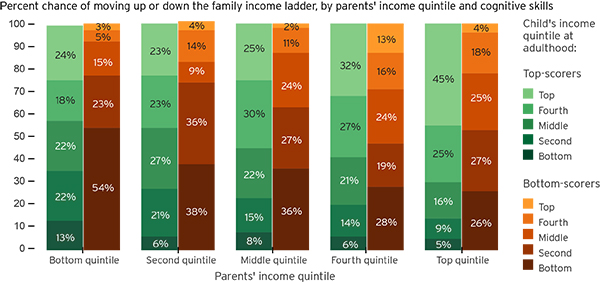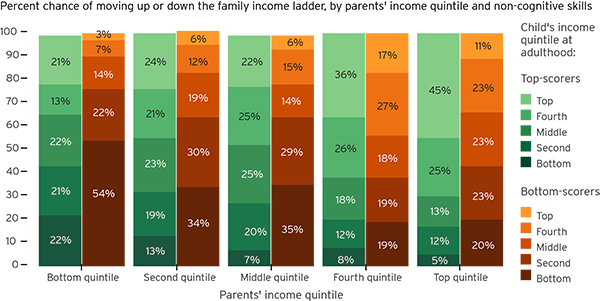The U.S. is not a meritocracy. As Kimberly Howard and I point out in our new paper “The Glass Floor,” there are plenty of smart, low-income kids who remain stuck at the bottom of the income distribution as adults—and plenty of less-smart, better-off kids who remain on a high rung of the ladder.
Skills Matter
This is not to say that skills don’t matter. In fact, skills matter a lot. We compare the mobility patterns for adolescents in the top and bottom third of scores for smarts (using a cognitive test) and those scoring high or low on a widely-used measure of “drive” or persistence (using a coding speed test).
“Smarts” Matter
The difference in the mobility patterns for the high-skill and low-skill adolescents, compared to overall patterns is striking. High-“smarts” adolescents in the bottom income quintile have a 24% chance of making it to the top quintile, which is similar to the rates seen among high-skill students in the middle income quintiles:

“Drive” Matters
The impact of non-cognitive skills is almost as great. Teens with a bottom third “drive” score in the top income quintile have a 20% chance of ending up in the bottom quintile as adults—almost identical to the 22% of those with bottom-third “drive” scores raised in the lowest income quintile:

Money Still Helps
It is also clear, however, that being born to the right parents remains a smart move. Low-scoring teens on the “smarts” test born into the top income quintile have a 22% chance of remaining in one of the top two income quintiles as an adult—compared to 8% of the equivalent group raised in the poorest quintile. It seems that affluence insulates individuals from the risks of downward mobility, even when they are relatively low-skilled.
So What?
- Assessing the fairness of mobility patterns requires us to look underneath the headline numbers to see whether society is rewarding talent, effort, and skill fairly. The question is not just “how much mobility is there?” but “how far do mobility patterns track merit?”
- Gaps in skill development—cognitive and non-cognitive—open up early (as we have noted in previous blog postings). By adolescence, inequalities in skill by income are already wide. Early intervention is therefore essential.
- Poverty and affluence dampen mobility in both directions, even allowing for some measure of skill. Smart, motivated, poor adolescents will still find it harder to reach the top of the ladder than smart, motivated, rich adolescents. And if anything, the stickiness in the other direction is greater still, with many teens born to higher-income parents held up by a “glass floor” even when their modest skill levels predict downward mobility. How you feel about that, of course, might depend on your own position on the income ladder!



Commentary
Skills Matter for U.S. Social Mobility
November 14, 2013